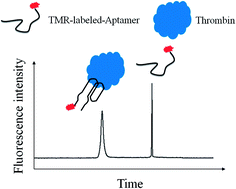当前位置:
X-MOL 学术
›
Anal. Methods
›
论文详情
Our official English website, www.x-mol.net, welcomes your
feedback! (Note: you will need to create a separate account there.)
Investigation of the effects of metal ions in sample buffer on capillary electrophoresis coupled with laser-induced fluorescence analysis of thrombin using a dye-labeled 29-mer DNA aptamer
Analytical Methods ( IF 2.7 ) Pub Date : 2017-09-04 00:00:00 , DOI: 10.1039/c7ay01791j Yunlong Bai 1, 2, 3, 4, 5 , Qiang Zhao 4, 5, 6, 7, 8
Analytical Methods ( IF 2.7 ) Pub Date : 2017-09-04 00:00:00 , DOI: 10.1039/c7ay01791j Yunlong Bai 1, 2, 3, 4, 5 , Qiang Zhao 4, 5, 6, 7, 8
Affiliation

|
Thrombin is an important serine protease in blood and a therapeutic biomarker. The aptamer-based assays for thrombin take advantage of unique features of nucleic acid aptamers in selection, preparation, stability, and modification of functional groups. Aptamer affinity capillary electrophoresis coupled with laser induced fluorescence (CE-LIF) analysis for thrombin uses a fluorescently labeled aptamer probe and relies on the change of electrophoretic mobility of the aptamer probe caused by protein–aptamer binding. A high-affinity 29-nt DNA aptamer (Apt29) has been used as an affinity probe in CE-LIF analysis of thrombin. In this work, we made a further detailed investigation of the effects of metal ions (e.g. Na+, K+, and Mg2+) in sample buffer on the CE-LIF analysis of thrombin using a dye labeled 29-mer DNA aptamer probe and achieved sensitive detection of thrombin. A complex of thrombin and the Apt29 probe was well separated from the unbound probe in CE separation. We found that the addition of K+ in sample buffer was not preferred in CE-LIF analysis of thrombin using dye-labeled Apt29, and it caused significant decrease of complex peaks of thrombin–Apt29. The use of both Na+ and Mg2+ in sample buffer was favorable for the sensitive detection of thrombin because a larger peak area of complex peaks of thrombin and the aptamer probe was obtained. Under the optimized conditions, as low as 0.1 nM thrombin was successfully detected with good specificity. This work shows that metal ions in sample buffer have a large effect on aptamer affinity CE-LIF analysis of thrombin using an Apt29 probe.
中文翻译:

研究染料缓冲液中金属离子对毛细管电泳的影响,以及使用染料标记的29-mer DNA适体对激光诱导的凝血酶进行荧光分析
凝血酶是血液中重要的丝氨酸蛋白酶,是一种治疗性生物标志物。凝血酶的基于适体的测定法在选择,制备,稳定性和修饰官能团方面利用了核酸适体的独特功能。适体亲和毛细管电泳与凝血酶的激光诱导荧光(CE-LIF)分析结合使用荧光标记的适体探针,并依赖于蛋白质-适体结合引起的适体探针电泳迁移率的变化。高亲和力的29-nt DNA适体(Apt29)已用作凝血酶的CE-LIF分析的亲和力探针。在这项工作中,我们对金属离子(例如Na +,K +和Mg 2+)在样品缓冲液中使用染料标记的29-mer DNA适体探针对凝血酶进行CE-LIF分析,并实现了对凝血酶的灵敏检测。在CE分离中,凝血酶和Apt29探针的复合物与未结合的探针完全分离。我们发现,在使用染料标记的Apt29对凝血酶进行CE-LIF分析时,在样品缓冲液中添加K +并不是优选的方法,这会导致凝血酶–Apt29的复杂峰显着降低。Na +和Mg 2+的使用由于获得了凝血酶和适体探针的复杂峰的更大的峰面积,因此样品缓冲液中的样品对凝血酶的灵敏检测是有利的。在优化的条件下,成功检测到低至0.1 nM的凝血酶,具有良好的特异性。这项工作表明,使用Apt29探针,样品缓冲液中的金属离子对凝血酶的适体亲和力CE-LIF分析有很大影响。
更新日期:2017-09-25
中文翻译:

研究染料缓冲液中金属离子对毛细管电泳的影响,以及使用染料标记的29-mer DNA适体对激光诱导的凝血酶进行荧光分析
凝血酶是血液中重要的丝氨酸蛋白酶,是一种治疗性生物标志物。凝血酶的基于适体的测定法在选择,制备,稳定性和修饰官能团方面利用了核酸适体的独特功能。适体亲和毛细管电泳与凝血酶的激光诱导荧光(CE-LIF)分析结合使用荧光标记的适体探针,并依赖于蛋白质-适体结合引起的适体探针电泳迁移率的变化。高亲和力的29-nt DNA适体(Apt29)已用作凝血酶的CE-LIF分析的亲和力探针。在这项工作中,我们对金属离子(例如Na +,K +和Mg 2+)在样品缓冲液中使用染料标记的29-mer DNA适体探针对凝血酶进行CE-LIF分析,并实现了对凝血酶的灵敏检测。在CE分离中,凝血酶和Apt29探针的复合物与未结合的探针完全分离。我们发现,在使用染料标记的Apt29对凝血酶进行CE-LIF分析时,在样品缓冲液中添加K +并不是优选的方法,这会导致凝血酶–Apt29的复杂峰显着降低。Na +和Mg 2+的使用由于获得了凝血酶和适体探针的复杂峰的更大的峰面积,因此样品缓冲液中的样品对凝血酶的灵敏检测是有利的。在优化的条件下,成功检测到低至0.1 nM的凝血酶,具有良好的特异性。这项工作表明,使用Apt29探针,样品缓冲液中的金属离子对凝血酶的适体亲和力CE-LIF分析有很大影响。











































 京公网安备 11010802027423号
京公网安备 11010802027423号